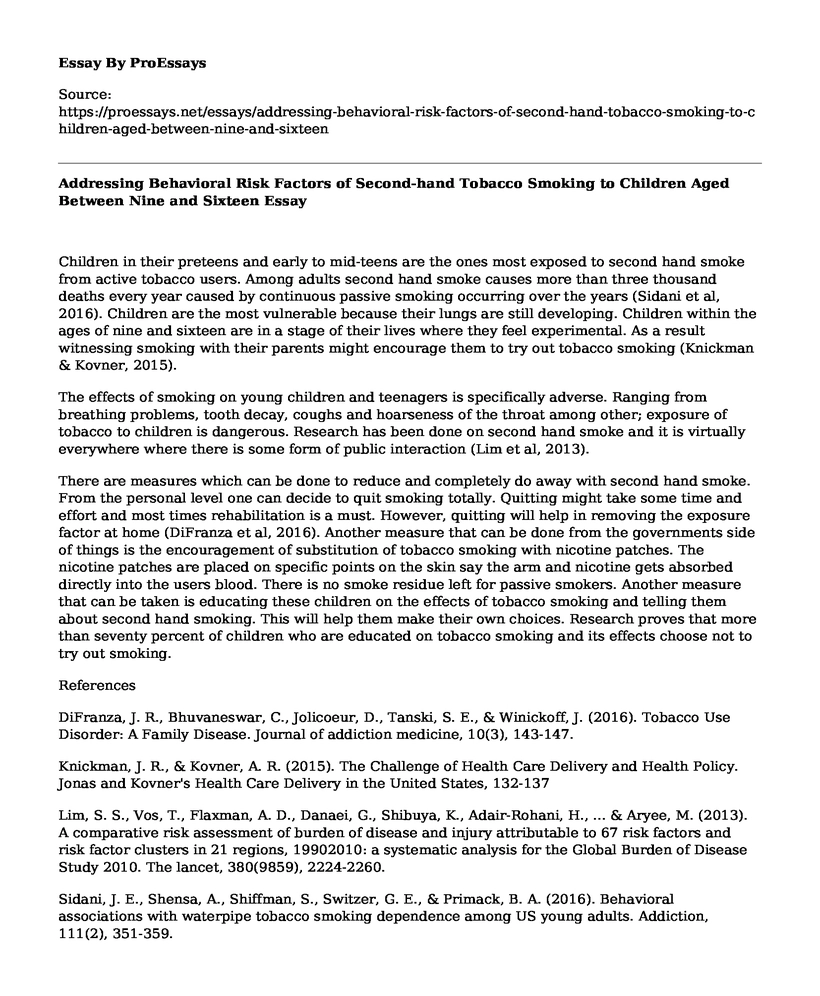Children in their preteens and early to mid-teens are the ones most exposed to second hand smoke from active tobacco users. Among adults second hand smoke causes more than three thousand deaths every year caused by continuous passive smoking occurring over the years (Sidani et al, 2016). Children are the most vulnerable because their lungs are still developing. Children within the ages of nine and sixteen are in a stage of their lives where they feel experimental. As a result witnessing smoking with their parents might encourage them to try out tobacco smoking (Knickman & Kovner, 2015).
The effects of smoking on young children and teenagers is specifically adverse. Ranging from breathing problems, tooth decay, coughs and hoarseness of the throat among other; exposure of tobacco to children is dangerous. Research has been done on second hand smoke and it is virtually everywhere where there is some form of public interaction (Lim et al, 2013).
There are measures which can be done to reduce and completely do away with second hand smoke. From the personal level one can decide to quit smoking totally. Quitting might take some time and effort and most times rehabilitation is a must. However, quitting will help in removing the exposure factor at home (DiFranza et al, 2016). Another measure that can be done from the governments side of things is the encouragement of substitution of tobacco smoking with nicotine patches. The nicotine patches are placed on specific points on the skin say the arm and nicotine gets absorbed directly into the users blood. There is no smoke residue left for passive smokers. Another measure that can be taken is educating these children on the effects of tobacco smoking and telling them about second hand smoking. This will help them make their own choices. Research proves that more than seventy percent of children who are educated on tobacco smoking and its effects choose not to try out smoking.
References
DiFranza, J. R., Bhuvaneswar, C., Jolicoeur, D., Tanski, S. E., & Winickoff, J. (2016). Tobacco Use Disorder: A Family Disease. Journal of addiction medicine, 10(3), 143-147.
Knickman, J. R., & Kovner, A. R. (2015). The Challenge of Health Care Delivery and Health Policy. Jonas and Kovner's Health Care Delivery in the United States, 132-137
Lim, S. S., Vos, T., Flaxman, A. D., Danaei, G., Shibuya, K., Adair-Rohani, H., ... & Aryee, M. (2013). A comparative risk assessment of burden of disease and injury attributable to 67 risk factors and risk factor clusters in 21 regions, 19902010: a systematic analysis for the Global Burden of Disease Study 2010. The lancet, 380(9859), 2224-2260.
Sidani, J. E., Shensa, A., Shiffman, S., Switzer, G. E., & Primack, B. A. (2016). Behavioral associations with waterpipe tobacco smoking dependence among US young adults. Addiction, 111(2), 351-359.
Cite this page
Addressing Behavioral Risk Factors of Second-hand Tobacco Smoking to Children Aged Between Nine and Sixteen. (2021, Mar 23). Retrieved from https://proessays.net/essays/addressing-behavioral-risk-factors-of-second-hand-tobacco-smoking-to-children-aged-between-nine-and-sixteen
If you are the original author of this essay and no longer wish to have it published on the ProEssays website, please click below to request its removal:
- Can Political Obligation Be Exlained Through the Idea of a Contract - Essay Sample
- Essay Example on Juvenile Delinquency: Violation of Law by Minors
- Essay Sample on Seizures: Common in Kids & Elderly, 10% of Population Affected
- Research Paper on 3 Purposes of Utterance: Thematic, Speech Act, Propositional
- Essay Example on Gender Roles in Religion: Women in Leadership?
- New Motherhood: Birth of My First Child - Free Report Example
- Impact of New ADHD Treatments - Free Essay Sample







